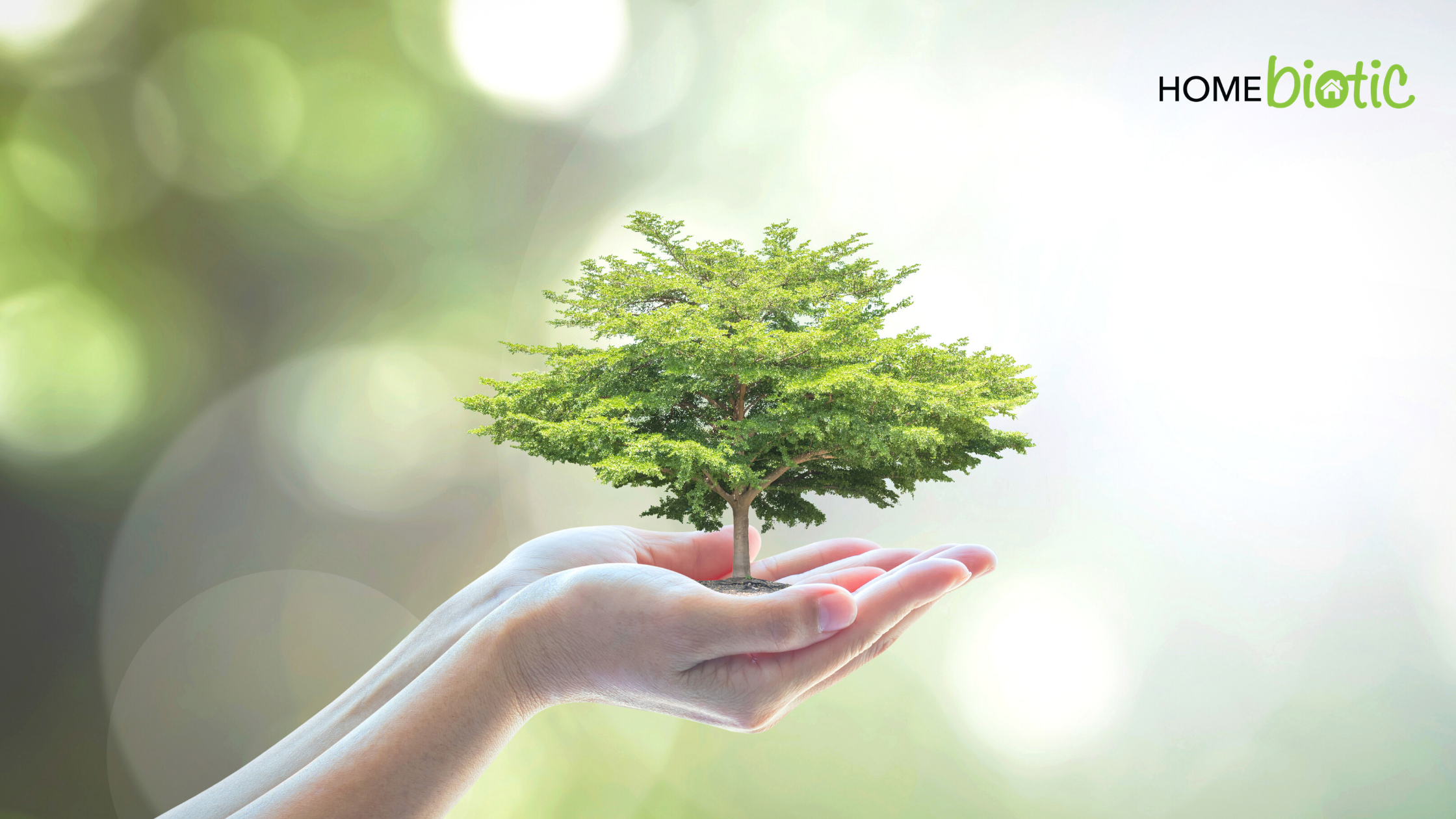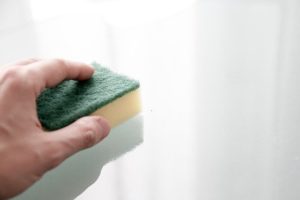How Mold Impacts the Environment

You may be familiar already with some of the health effects associated with mold exposure, but have you considered how mold impacts the environment? The environmental impacts can go much further than the initial mold issue. Specifically, the impacts of traditional mold killing remedies can have far-reaching environmental effects.
Many people tend to reach for a bottle of bleach (or other bleach-based products) when tackling household mold issues, but as we’ve discussed before, bleach is not a good choice for dealing with mold. Beyond the health impacts of exposure to bleach, its use can lead to significant environmental impacts within your home and the areas around your home.
 Negative Impact: Air Quality
Negative Impact: Air Quality
According to the EPA, Americans spend roughly 90% of the time inside,1 where the concentrations of some pollutants are 2 to 5 times higher than concentrations typically found outdoors2. This situation is made worse when we consider that the people who are most vulnerable to poor air quality (eg. infants and children, the elderly, and anyone suffering from respiratory or cardiovascular disease) tend to spend more time indoors than others3.
In recent decades, as buildings have become more and more airtight for energy efficiency (itself not a bad thing, of course), indoor pollution levels have risen sharply. This is primarily due to a lack of sufficient mechanical ventilation in sealed buildings to allow adequate air exchange, as well as the rise in popularity of industrial-strength cleaning products now marketed for home use4.
In recent decades, as buildings have become more and more airtight for energy efficiency (itself not a bad thing, of course), indoor pollution levels have risen sharply. This is primarily due to a lack of sufficient mechanical… Share on XUsually, because these products tend to be extremely irritating to your eyes and mucous membranes (nose, throat, lungs), it’s suggested that they are only used in a “well-ventilated” area3. While this certainly can remove the pollutants from the immediate vicinity of the person using them, it does still result in noxious fumes being released to the outside air. In past decades, the phrase “Dilution is the solution to pollution!” was often repeated, but despite the catchy rhyme, it’s definitely not a solution. It’s also not just for air. This applies to what goes down your drain as well.
 Negative Impact: Water Quality
Negative Impact: Water Quality
If you live in a rural area or are on a septic system, you’ll no doubt already be aware that flushing bleach down your drain is a big no-no. But did you know that it’s also bad even if you are on a city sewer system? Nearly every wastewater treatment system uses bacteria to break down sewage, and exposure to antiseptic products within the wastewater can disrupt the beneficial bacteria. This can result in a reduced or incomplete breakdown of the biological material. In addition, many wastewater treatment systems are not designed to break down chemicals and so often they pass right through the system and are discharged into a lake, river, or other nearby body of water – sometimes the same body of water where drinking water is sourced from!
many wastewater treatment systems are not designed to break down chemicals and so often they pass right through the system and are discharged into a lake, river, or other nearby body of water - sometimes the same body of water where… Share on XIt gets worse.
Common household bleach, also known as sodium hypochlorite, contains a reactive chlorine atom which readily reacts with both organic and inorganic material in water to form a group of substances called trihalomethanes. The 4 trihalomethanes are chloroform, bromodichloromethane, dibromochloromethane, and bromoform5. These are all byproducts of the reaction of disinfection products with non-purified water, such as is found in household wastewater. Each of these is a Cancer Group B carcinogen (substances shown to cause cancer in laboratory animals).
Trichloromethane (chloroform) is by far the most common in most water systems. Dibromochloromethane is the most serious cancer risk, (0.6 ug/l to cause a 10-6 cancer risk increase) followed in order by Bromoform (4 ug/l), and Chloroform (6 ug/l). EPA regulations strictly limit these chemicals at a maximum allowable annual average level of 80 parts per billion (80ppb) when used in drinking water purification systems, but there are no such controls for household wastewater6. With either a compromised city wastewater system or a rural septic system that could potentially contaminate a well or nearby body of water, these pose significant health and environmental hazards.7

Is There A Better Choice For Cleaning Mold?
Rather than using toxic cleaning products that create harmful fumes (Volatile Organic Compounds, or VOCs) that must be vented to the outside environment or using products that create disinfectant byproducts that are known to be carcinogenic, consider a more eco-friendly alternative.
Hydrogen peroxide, h2o2, can be as effective as bleach in disinfecting a surface but lacks the numerous negative side effects. The reaction uses oxidation rather than a chlorine reaction and produces only water as a byproduct, and no harmful fumes. Hydrogen peroxide, at a concentration of 3%, is effective for killing minor mold growth and disinfecting affected surfaces. It may discolor some materials, so be sure to spot test in an inconspicuous area first. This concentration of hydrogen peroxide is easily found at most grocery stores, drug stores, and of course online. A higher concentration of 7% can be found at chemical supply shops, beauty supply shops, and from online retailers including Amazon, and is more effective, but should be used with caution.
Hydrogen peroxide, h2o2, can be as effective as bleach in disinfecting a surface but lacks the numerous negative side effects. The reaction uses oxidation rather than a chlorine reaction and produces only water as a byproduct, and no… Share on XHow To Use Hydrogen Peroxide On Mold
A common spray mister cap can be attached straight to the hydrogen peroxide bottle and sprayed onto mold spots. This will most likely generate a fizzing reaction for a few seconds up to a few minutes. Carefully wipe the spots away after the fizzing has subsided and at least 10 minutes have passed, and let the surface dry. If there is still mold visible, or it has left stains, you can repeat the hydrogen peroxide application several more times as needed. It’s advised that personal protective equipment be used when cleaning even minor mold spots, including a proper mask, rubber gloves, and eye protection. While the use of reusable microfiber cloths is advisable in many situations, this is not one of them. The mold should be wiped away with a disposable cloth such as a paper towel, which should be discarded immediately. You will likely want to have a fan operating nearby to help remove any excess humidity, although it is not required for the removal of fumes as there will not be any produced.
REFERENCES
1. https://www.osti.gov/biblio/6958939-report-congress-indoor-air-quality-volume-assessment-control-indoor-air-pollution-final-report
2. https://www.osti.gov/biblio/5936245
3. https://rais.ornl.gov/documents/EFH_Final_1997_EPA600P95002Fa.pdf
4. https://www.epa.gov/sites/production/files/2013-08/documents/nas_report_for_web.pdf
5. https://water-research.net/index.php/trihalomethanes-disinfection
6. https://water.epa.gov/lawsregs/rulesregs/sdwa/stage1/
7. https://des.nh.gov/organization/commissioner/pip/factsheets/ard/documents/ard-ehp-13.pdf
